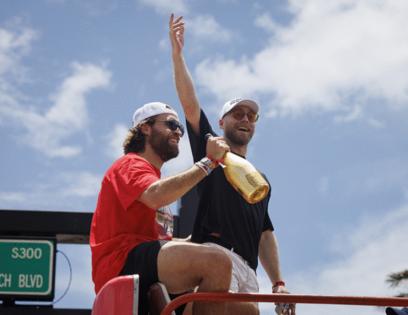Can the Panthers really keep Ekblad, Bennett and Marchand? How it might work.
Published in Hockey
MIAMI — Aaron Ekblad wants to stay with the Florida Panthers. So does Sam Bennett. And, unsurprisingly, so does Brad Marchand.
That’s three big powerhouses for this franchise, a trio of players who were integral in Florida repeating as Stanley Cup champions.
It’s going to be the first order of business for Panthers president of hockey operations and general manager Bill Zito to sort out over the next week before all three are set to become free agents on July 1.
Zito has said that there’s a path to keeping all three on the roster.
It likely won’t be easy, but let’s break down what that path might look like.
What does the Florida Panthers’ roster situation and salary cap look like?
The Panthers are currently $19 million under the $95.5 million salary cap with 16 players under contract — 10 forwards, five defensemen and one goaltender.
This is how much money they have to work with to fill out their roster, including potentially bringing back Bennett, Ekblad and Marchand. Overall, Florida at minimum needs to sign two forwards, one defenseman and one goaltender, although teams can carry up to 23 players — typically 14 forwards, seven defensemen and two goaltenders — on the active roster.
Beyond the big trio, forward Mackie Samoskevich is a restricted free agent who Florida will most likely retain. Four other contributors from Florida’s Cup run — forwards Tomas Nosek and Nico Sturm, defenseman Nate Schmidt and backup goaltender Vitek Vanecek — are slated to become unrestricted free agents.
What is each player being projected to make?
This is where things get tricky because all three very likely would be able to make more on the open market than they would by resigning with Florida.
The general consensus for Bennett, who has been Florida’s second-line center the past three years and brings a blend of physicality and scoring touch, is somewhere around $8 million per year over an eight-year extension.
The numbers on Marchand and Ekblad are a little less cut and dry.
Marchand, at 37, is most likely going to get a shorter deal in the three or four year range. It’s a matter of money. If he’s willing to spread out an identical amount of money over four years compared to three, thus lowering his average annual value and therefore his cap hit, there’s a way he stays in Florida.
As for Ekblad, who played his entire 11-season career with the Panthers, he’s coming off an eight-year, $60 million deal that had a $7.5 million annual cap hit. He almost certainly won’t be making that type of per-year money with Florida this time around, considering Florida’s highest paid defensemen right now are Seth Jones ($7 million per year) and Gustav Forsling ($5.75 million per year).
How much of a pay cut he’s willing to take will determine if he’s able to stay with the Panthers.
When do teams have to be cap compliant?
Teams’ active rosters have to be at or under the salary cap by Opening Night of the season. Teams are able to be up to 10% over the salary cap — so $9.55 million above the $95.5 million ceiling — over the offseason before finalizing the roster at the start of the season.
This gives teams wiggle room to add extra players whose salaries might not count when the season begins, whether it’s because players get traded, waived, sent to the minor leagues or start a season on long-term injured reserve (more on that last point in a moment).
Can the Panthers add cap space?
Yes. There are two potential avenues on this front — one permanent and one temporary.
The first is Florida could trade a player under contract for prospects or draft picks to offload that player’s salary and therefore add cap space.
Looking at the roster, the only player making significant enough money that doesn’t have a no-movement clause in his contract is forward Evan Rodrigues, who has a cap hit of $3 million each of the next two seasons. Rodrigues has played a key role for Florida the past two seasons but doesn’t necessarily have a defined role. He is the player coach Paul Maurice has moved up and down the lineup to fill whatever gap is needed, a Swiss Army Knife of sorts. There’s value in that, but Florida also has a player in Jesper Boqvist who can assume that role and is under contract for half the cost.
If Rodrigues hypothetically were to be dealt, that would jump Florida’s cap space to $22 million.
The other players on the roster without no movement clauses, in descending order of cap hit for next season, are center Anton Lundell ($5 million), forward Eetu Luostarinen ($3 million), defenseman Niko Mikkola ($2.5 million), Boqvist ($1.5 million), defenseman Dmitry Kulikov ($1.15 million), forward A.J. Greer ($850,000), defenseman Uvis Balinskis ($850,000) and forward Jonah Gadjovich ($775,000).
And then there’s the possibility of Florida having a player start the season on long-term injured reserve. A player’s salary does not count toward the cap while he is on LTIR, freeing up space for the team to add players to the roster in his absence. Players on LTIR must miss a minimum of 10 games or 24 days of the season, whichever is the longer amount of time missed among the two.
In this case, we’re talking about Matthew Tkachuk. The star winger, who carries a $9.5 million cap hit, played through a pair of major injuries — an adductor muscle that tore off the bone and a sports hernia — in the postseason. He said on Saturday that there’s a 50-50 chance he would need surgery this offseason.
Should that happen, it’s likely Tkachuk would not be ready to start the season and they could use LTIR to provide temporary salary cap relief.
____
©2025 Miami Herald. Visit miamiherald.com. Distributed by Tribune Content Agency, LLC.







Comments